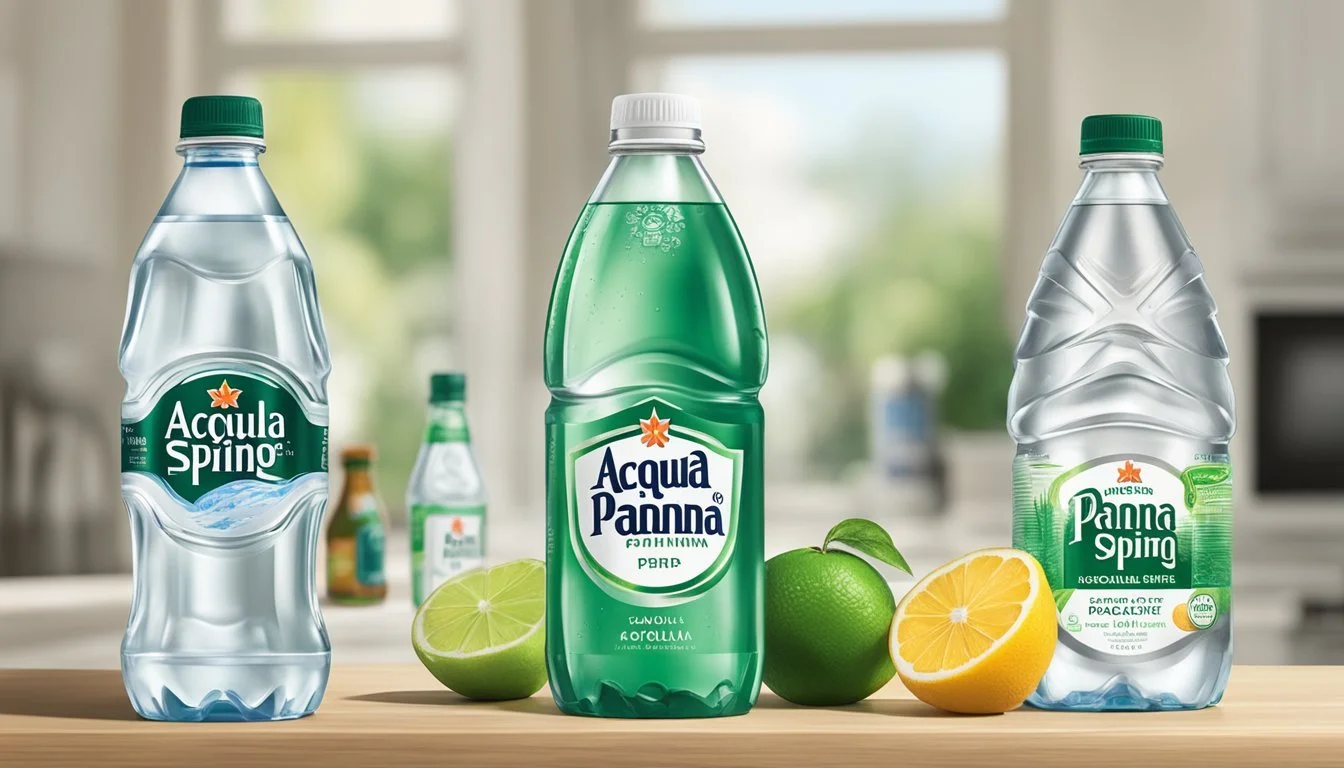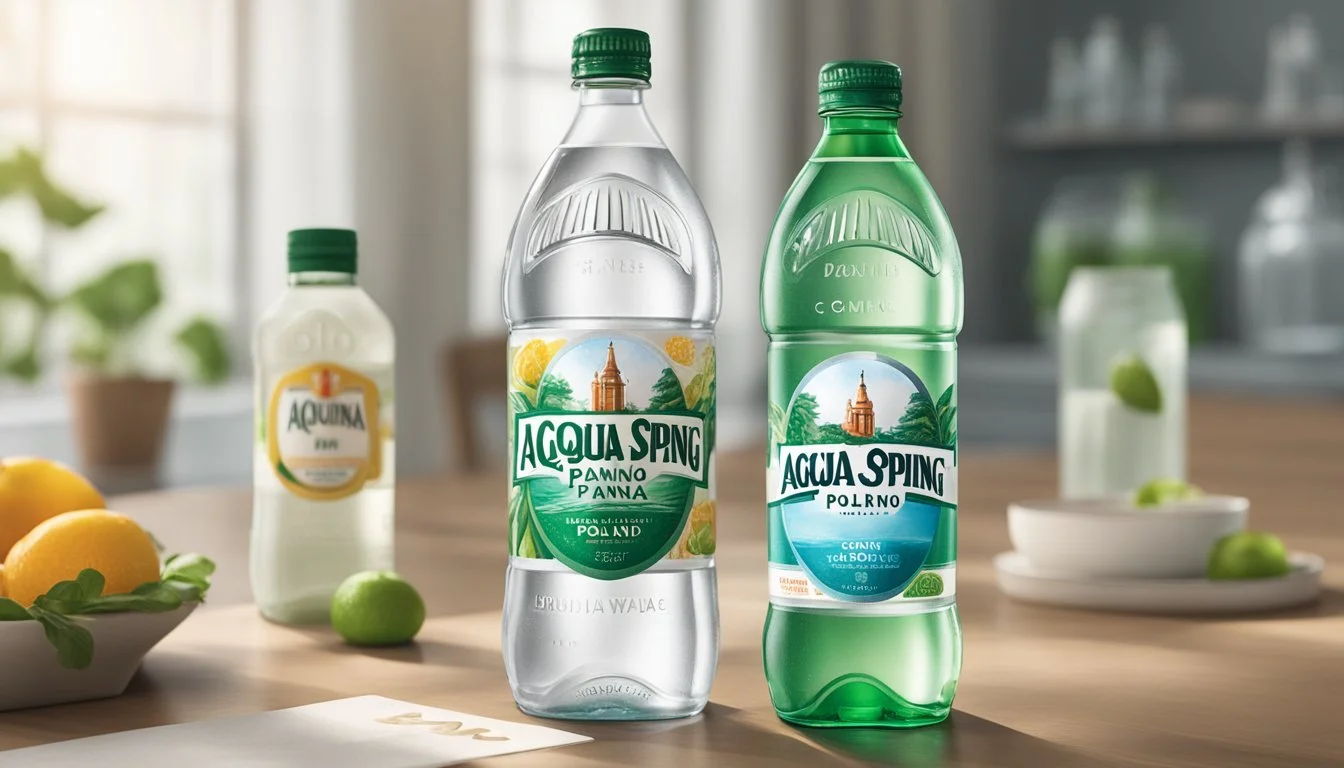Acqua Panna vs. Poland Spring
A Comparative Guide to Bottled Water Quality
In the realm of bottled water, two names often rise to the surface: Acqua Panna and Poland Spring. These brands have established themselves as staples within the bottled water market, each offering a distinct taste profile and source credibility. Acqua Panna, hailing from Italy, is renowned for its smooth taste and originates from the hills of Tuscany. This brand is often lauded for its purity and natural filtration through limestone hills, which imparts a unique mineral composition.
On the other hand, Poland Spring emanates from multiple springs in Maine and has been a familiar choice for consumers across the United States. The brand boasts a history of natural filtration and emphasizes its commitment to sustainability and environmental stewardship. With such differing backgrounds, consumers frequently debate which water offers better quality, taste, and value.
Comparing Acqua Panna and Poland Spring involves more than just sipping and scoring; it encompasses an evaluation of their sources, processing methods, environmental impact, and how they fit into the broader picture of consumer preferences and health standards. Both brands have their devout followers and critics, making the debate over which bottled water reigns supreme anything but crystal clear.
Historical Background and Origin
Acqua Panna stands as a historic bottled water brand rooted in the picturesque landscapes of Tuscany, Italy. The water springs from an unspoiled source within the Tuscan Apennines, specifically the serene hills surrounding the Villa Panna. With a legacy dating back to 1564, the brand lays claim to a noble heritage, but water bottling started in earnest in 1880. It is well-known for its still, uncarbonated quality, emerging from a long journey through the aquifer that spans 13 years before reaching its pristine source for bottling.
In contrast, Poland Spring represents a notable American bottled water brand with a history that originates from Maine. It is named after the initial water source in Poland, Maine, where commercial bottling began in 1859, instigated by Hiram Ricker, an inn owner captivated by the spring's virtues. Today, Poland Spring is part of BlueTriton Brands, with the original source still playing a role in its identity.
Both brands draw from historically significant sources, emphasizing purity and natural filtration processes. Acqua Panna's journey through the Tuscan aquifer adds unique mineral content to the water, while Poland Spring emphasizes the natural qualities derived from Maine's protected springs. Neither brand imports water from distant sources such as the French Alps, Mauna Loa volcano, Iceland’s Víti Levu, the Ouachita Mountains, nor Norway; instead, they focus on the authentic and natural qualities of their local regions.
Types of Bottled Water
When considering bottled water, it's important to understand the different types available on the market. Factors such as the source, treatment process, and mineral content distinguish these waters from one another, influencing both taste and health benefits.
Spring Water
Spring water originates from underground sources from which water naturally rises to the surface. Acqua Panna is an example of spring water—it's known for its purity and naturally occurring minerals. The presence of minerals like calcium, magnesium, and bicarbonate can enhance the taste and may offer health benefits.
Common Minerals Found in Spring Water:
Calcium
Magnesium
Potassium
Silica
Bicarbonate
Mineral Water
Mineral water is characterized by its constant level and relative proportions of minerals and trace elements at the point of emergence from the source. It's set apart from other types of bottled water by its constant mineral composition, which usually includes elements like sodium, calcium, and magnesium.
Minerals and Electrolytes:
Sodium: Varies by brand
Calcium: Essential for bone health
Magnesium: Important for metabolism
Potassium: Vital for muscle function
Bicarbonate: Can influence pH balance
Alkaline Water
Alkaline water has a higher pH level than tap water, typically because of the addition of alkaline minerals, such as calcium and magnesium, or through an ionization process. Proponents claim that alkaline water can help neutralize acid in the bloodstream, but the scientific community has not reached a consensus on these benefits.
pH Levels:
Typically above 7 (neutral)
Purified Water
Purified water refers to water that has been processed to remove impurities like chemicals and contaminants. This category includes distilled water and water purified through processes like reverse osmosis or deionization. Purified water may also lack many of the minerals found in spring or mineral water.
Purification Methods:
Distillation
Reverse Osmosis
Deionization
Total Dissolved Solids (TDS):
Significantly reduced compared to spring or mineral water
Health and Hydration
In comparing Acqua Panna and Poland Spring, one must consider their mineral content and their capacity to maintain hydration and electrolyte balance, which are essential for health.
Mineral Content and Health Benefits
Acqua Panna touts a notable composition of minerals like calcium, magnesium, and bicarbonates. The presence of these minerals are often linked to benefits such as bone health and metabolic function. The pH level of Acqua Panna is slightly alkaline, often hovering around 8.0, which some prefer for its taste and potential health perks.
Poland Spring, sourced from multiple springs in Maine, also contains various minerals, though its mineral content may vary slightly depending on the source. These minerals are integral for basic body functions and contribute to the overall health profile of the water.
Hydration and Electrolyte Balance
When it comes to hydration, both brands provide adequate fluids to maintain bodily functions. However, the electrolyte balance is a key factor that enhances hydration efficiency. The electrolytes in Acqua Panna, such as sodium and potassium, are beneficial for rehydration, especially after exercise.
Poland Spring's natural electrolytes support the maintenance of hydration and play a role in nerve signaling and muscle contraction. Neither water has added electrolytes, which means they rely on their natural mineral content to aid in hydration and electrolyte balance.
Taste Profile
When comparing Acqua Panna and Poland Spring, one must consider the unique taste profile of each brand. Acqua Panna originates from Tuscany, Italy and has a smooth taste with a hint of sweetness due to its natural mineral content. Its journey through limestone rocks in the Apennine Mountains adds to its mineral complexity and soft mouthfeel.
Poland Spring, sourced from Maine, United States, is known for its clean and refreshing taste with a balanced pH. The brand often touts that the water is naturally filtered and spring-sourced, which contributes to its fresh taste profile.
Here is a breakdown of how these water brands compare in terms of their taste nuances, influenced by natural minerals found in the water.
Water Brand Dominant Minerals Taste Perception Acqua Panna Calcium, Magnesium, Silica Smooth, slightly sweet Poland Spring Calcium, Magnesium, Sodium Crisp, neutral
Both brands avoid the flat taste that can come from de-mineralized water; they retain their natural water character through safeguarded sourcing and minimal processing. The presence of minerals like calcuim and magnesium is responsible for the subtle flavor notes that distinguish these waters apart from ordinary tap water.
It's the delicate balance of these natural minerals in Acqua Panna and Poland Spring that shapes their taste profiles, appealing to different consumer preferences without compromising on the quality of the water.
Environmental Impact and Sustainability
In assessing the environmental impact and sustainability of Acqua Panna and Poland Spring bottled waters, it's crucial to consider the materials used in bottling, the management of water sources, and efforts towards recycling and waste reduction.
Bottling Process and Material
Both Acqua Panna and Poland Spring utilize different materials for their packaging, which have varying degrees of environmental impact. Acqua Panna is known for its glass bottles, which are widely recyclable and can be reused multiple times before recycling. Glass production, however, requires significant energy and resources. Poland Spring, on the other hand, has shifted towards 100% recycled plastic for some products, notably their Poland Spring brand. Plastic bottles use less energy to produce than glass but are often critiqued for their persistence in the environment if not properly recycled.
Water Source Management
Sustainability of water sources is a critical element for bottled water brands. Acqua Panna sources its water from a natural spring in Tuscany, with a focus on preserving the quality and sustainability of the spring. They emphasize natural filtration and the protection of surrounding ecosystems. Poland Spring also claims to implement sustainable water management practices for its springs in Maine, constantly monitoring and managing their use of water to ensure long-term sustainability.
Recycling and Waste Reduction
Recycling initiatives are paramount in reducing the environmental impact of bottled water. While glass is highly recyclable, the challenge lies in ensuring that the bottles are actually recycled by consumers and facilities. Poland Spring's adoption of recycled plastics is a step towards waste reduction, as it supports the market for recycled materials. However, both brands must contend with the reality that not all bottles are recycled, which contributes to environmental waste. Efforts to promote and simplify recycling for consumers are on-going and essential to minimizing the environmental footprint of bottled water.
To truly assess the sustainability of these products, it's important to analyze not just the packaging, but also the full lifecycle of the product, including the impact of extraction, production, distribution, and post-consumer waste. Both Acqua Panna and Poland Spring are actively pursuing improvements in these areas, but the challenges associated with bottled water and sustainability are complex and require concerted effort from companies and consumers alike.
Market and Consumer Preferences
The bottled water market is shaped by consumer preferences, with brands like Acqua Panna and Poland Spring catering to the demand for both purity and taste. This section examines the standing of these brands in the market and observes consumer behavior trends that influence their choices.
Brand Analysis
Acqua Panna, sourced from an Italian spring, presents itself with a heritage of purity and taste. It is bottled by San Pellegrino, a name that resonates with luxury in the consumer's mind. On the contrary, Poland Spring, emanating from Maine, leverages its American origin and is often perceived as a staple household water brand. While Acqua Panna is seen as a high-end option, brands like Fiji Water, Voss, and Evian offer similar competition, influencing market dynamics with their distinct brand propositions.
In contrast, products from companies such as Coca-Cola and Nestlé, which own Dasani and Pure Life respectively, tend to be categorized lower on the premium scale but have a significant market share due to their affordability and accessibility. Dasani, for instance, despite its market presence, often faces criticism over taste and source.
Consumer Trends
Consumers today are increasingly interested in the origin and processing of the water they drink. The trends show a growing inclination towards naturally-sourced waters, potentially influencing the demand for brands like Acqua Panna. Terms like "spring water" and "artesian water" are becoming part of the everyday vocabulary, with the likes of Icelandic Glacial and Eternal Water gaining traction for their exotic sources.
Concurrently, there's an uptick in awareness around the environmental impact of bottled water. As a result, companies like La Croix and Life WTR (LIFEWTR), which offer sparkling and art-inspired bottles, are innovating with eco-friendly packaging and branding to appeal to environmentally-conscious consumers. The usage of ultraviolet light and ozone in bottling processes is being scrutinized more than ever, with safety standards set by organizations such as the EPA serving as a significant consideration for health-focused individuals.
Safety and Regulations
In assessing the safety and quality of bottled waters such as Acqua Panna and Poland Spring, one must consider the regulations and standards that govern the industry and how they compare to tap water.
Bottled Water Standards
Bottled water, including brands like Acqua Panna and Poland Spring, is regulated as a food product by the U.S. Food and Drug Administration (FDA). The FDA ensures these products meet strict safety and quality standards, which often mirror those set by the Environmental Protection Agency (EPA) for public water systems. The standards cover a range of contaminants, including:
Microbiological contaminants
Chemical contaminants
Radiological contaminants
For example, the FDA’s standards specify maximum contaminant levels for chemicals like lead, arsenic, and certain organic compounds.
Comparison with Tap Water
Tap water is regulated by the EPA under the Safe Drinking Water Act, which provides guidelines on clean drinking water that all public water systems must adhere to. Bottled water companies often emphasize the purity of their water, but both Acqua Panna and Poland Spring must maintain safety levels comparable to EPA regulations for tap water. While the sources may differ, with many bottled waters being sourced from springs or underground wells, the end goal is the same: to provide safe, contaminant-free drinking water to consumers.
It’s important to note that tap water undergoes regular testing and reporting to consumers, while bottled water companies are not required to provide their test results to the public, although they must maintain records that can be requested by the FDA.
In summary, both Acqua Panna and Poland Spring adhere to stringent bottled water standards set by the FDA, intended to ensure safety and quality comparable to EPA-regulated tap water, protecting consumers from various contaminants.
Filtration and Purification Techniques
Filtration and purification processes are critical in ensuring the safety and quality of bottled water. Both reverse osmosis and carbon filtration are widely used methods, while UV purification serves as an additional safeguard against microorganisms.
Reverse Osmosis
Reverse osmosis (RO) is a filtration process that removes impurities from water by forcing it through a semipermeable membrane. This method is effective in eliminating salts, fluoride, and other contaminants to produce water that is essentially pure. It is used extensively in the bottled water industry.
Carbon Filters
Carbon filters utilize activated carbon to remove chlorine, sediment, volatile organic compounds (VOCs), taste, and odor from water. They work through adsorption, where contaminant molecules adhere to the surface of the activated carbon.
UV Purification
UV purification employs ultraviolet light to disinfect water by destroying the DNA of pathogenic organisms, thereby rendering them harmless and preventing them from multiplying. It is a chemical-free process, which ensures the water does not have any altered taste or odor from the purification process.
Packaging and Convenience
When comparing Acqua Panna and Poland Spring, it is essential to consider the packaging materials and designs they employ, along with how these factors influence convenience of portability and storage.
Bottle Design and Materials
Acqua Panna distinguishes itself with its smooth, aesthetically pleasing glass bottles, which are often associated with elegance and can be recycled indefinitely. However, glass does make the bottles heavier and potentially more prone to breaking. Poland Spring mainly utilizes plastic bottles that are lightweight and durable, making them a practical choice for everyday use. In recent years, Poland Spring has integrated recycled materials in their bottles to reduce environmental impact.
Portability and Storage
For those on the go, Poland Spring offers a high level of portability, with various bottle sizes that easily fit into car cup holders, backpacks, and refrigerators. Their compact design ensures efficient storage, both in retail settings and at home. Acqua Panna’s glass bottles, while more delicate, provide a premium experience and are better suited for formal occasions. Despite being less ideal for vigorous activities, they are still designed to be transportable and stored without hassle, albeit with extra care to avoid breakage.
Consumer Tips
When choosing between water brands like Acqua Panna and Poland Spring, consumers should consider several factors to make a smart purchasing decision. The following tips can guide them:
Source and Quality: Acqua Panna is sourced from the hills of Tuscany and has a natural alkaline pH, while Poland Spring originates from multiple springs in Maine. Consumers may prefer one source over the other based on taste or pH preferences.
Packaging: Acqua Panna comes in glass and plastic bottles, whereas Poland Spring is typically found in plastic bottles. For those environmentally conscious, glass might be the better choice.
Aspect Acqua Panna Poland Spring Bottle Material Glass & Plastic Plastic pH Level Natural Alkaline Neutral to Slightly Alkaline
Taste: Individual taste preferences can vary widely. If possible, consumers may want to try a small bottle of each before committing to a larger purchase.
Certifications: Look for any quality certifications like NSF or IBWA to ensure the water meets certain health and safety standards.
For hydration tips, remember:
Frequency: It's better to sip water regularly throughout the day than to drink large amounts infrequently.
Temperature: Some individuals prefer the refreshing taste of chilled water, while others might prefer room temperature for easier drinking.
Remember, proper hydration is key to maintaining health, so regardless of brand choice, consumers should aim to consume an appropriate amount of water daily.
Closing Thoughts
When evaluating bottled waters like Acqua Panna and Poland Spring, one should consider the source, taste, mineral content, and packaging. Acqua Panna, sourced from Tuscany, is synonymous with smoothness and a velvety texture, often preferred by those who appreciate a fine dining experience. On the other hand, Poland Spring, originating from Maine, is a common choice for American consumers, known for its accessibility and consistent quality.
Source:
Acqua Panna: Tuscany, Italy
Poland Spring: Maine, USA
Taste:
Acqua Panna: Smooth, velvety
Poland Spring: Clean, neutral
Mineral Content: Varies between brands, influencing flavor and potential health benefits.
Packaging: Both brands offer a range of bottle sizes and materials.
Decision-making may also weigh on environmental factors, where the impact of plastic usage and the carbon footprint of international shipping for Acqua Panna are of concern to eco-conscious consumers. Poland Spring, although domestic for the U.S. market, still faces criticisms regarding environmental implications.
In conclusion, both Acqua Panna and Poland Spring hold their respective appeal. The former is often regarded for its refined taste, while the latter for its broad availability and reliable taste profile. Consumers' preferences will vary based on individual taste, environmental considerations, and the intended use – be that everyday hydration or pairing with gourmet meals.








